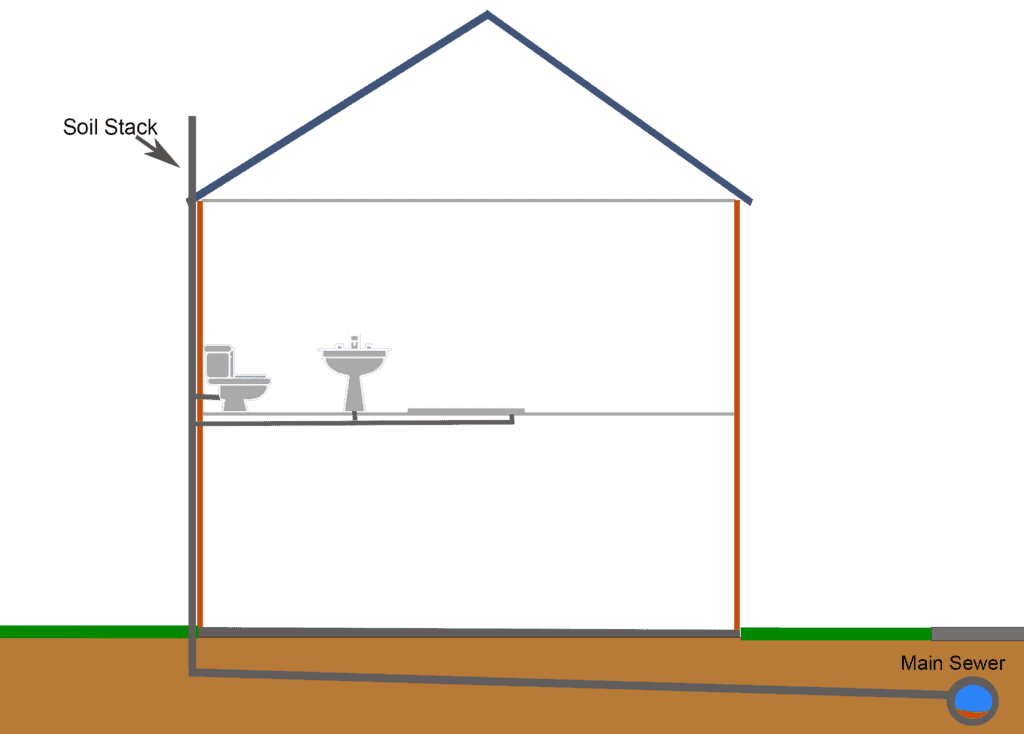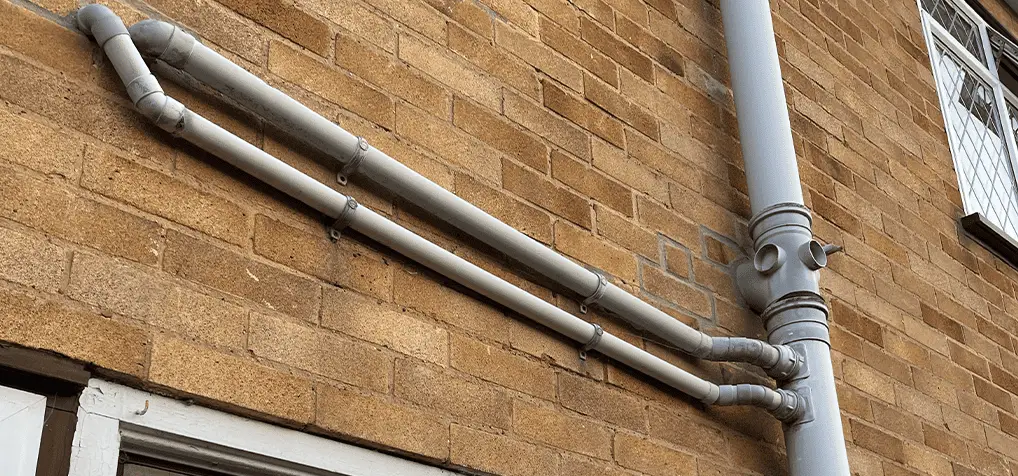It is quite common among homeowners and DIY enthusiasts in the United Kingdom seeking to understand the practicality and considerations involved in connecting toilets and showers. This question arises for various reasons: space limitations, plumbing efficiency, and cost-effectiveness. By exploring this aspect, we aim to share insights into the feasibility and potential challenges associated with such plumbing arrangements in their UK-based homes.
So Can Toilets And Showers Be Connected To The Same Drain
Toilets and showers can be connected to the same drain. It is common for bathrooms to have a single waste pipe that connects to the main sewer line. This is known as a soil stack or drain-waste-vent (DWV) system. The soil stack carries all waste and water from your bathroom into the main sewer.
Table of Contents
Things To Consider When Connecting A Toilet And Shower To The Same Drain
It is essential to consider the size and capacity of the pipes. The size of the pipes will depend on the number of fixtures within the same waste pipe. For example, if you run a 1"1/2 waste pipe and then connect a basin, shower and bathtub, the pipe size would to too small; therefore, you would need to upgrade the waste pipe size to 2", otherwise they can become blocked or slow draining, causing backups and other issues.
It is also important to ensure that the pipes are properly vented. Venting allows air to enter the pipes, which prevents a vacuum from forming and allows waste and water to flow freely. Fixtures can drain slowly without proper venting, and unpleasant odours can build up in the pipes.
Below I have listed some pros and Cons.
Pro's
Space-saving: Connecting toilets and showers to the same drain allows for efficient utilization of available space, particularly in smaller bathrooms where separate drain systems may not be practical.
Cost-effective: Consolidating the drainage system for toilets and showers can save on plumbing installation and maintenance costs, as there is a reduced need for separate pipes, traps, and vents.
Simplified plumbing: Connecting both fixtures to the same soil stack simplifies the overall plumbing layout, making it easier to install and maintain.
Efficient water flow: When both fixtures are connected to the same drain, the water from your shower can help flush waste from your toilet, reducing the amount of water you need for flushing.
Con's
Blockages: In the event that a toilet and shower are connected to the same soil stack and a blockage occurs, there is a risk of wastewater from the toilet backing up and rising into the shower tray.
Potential odours: When the shower is closely connected to the soil stack, there is a possibility that when the toilet is flushed, the water from the toilet could create a suction effect and draw the water out of the shower tray trap.
How Toilets And Showers Can Be Connected To The Same Drain
Connecting toilets and showers to the same drain is common in many households. This is because it saves space and money. However, it is important to do it right to avoid any issues with the plumbing system. Here's how to connect toilets and showers to the same drain:
1. Plan the Layout
Before you start connecting the pipes, you need to plan the layout. This will help you determine the best flow from your bathroom fixtures. You should also consider the size of the waste pipes and the distance between the fixtures.
2. Choose the Right Pipes
You must use the right waste pipes when connecting toilets and showers to the same drain. The pipes should be large enough to handle the flow of water and waste.
3. Install the Pipes
Once you have planned the layout and chosen the right pipes, you can start installing the waste pipes from your bathroom fixtures, ensuring the flow leads away from the fixture towards the soil stack to help the waste water drain away.
4. Test the System
After installing the pipes, you should test the system to ensure everything works properly. You can do this by flushing the toilet and running the shower simultaneously. If there are any issues, you should address them immediately.
Can Toilets And Bath Tubs Be Connected To The Same Drain
Toilets and bathtubs can be connected to a shared drain, allowing for efficient wastewater management in UK plumbing systems. This practice optimizes space, simplifies plumbing layouts, and reduces costs. Proper installation, venting, and maintenance are essential to avoid potential issues.
Can Toilets And Bathroom Sinks Be Connected To The Same Drain
Toilets and bathroom sinks in UK plumbing systems can be interconnected, sharing a common drain for effective drainage. This integration optimizes space, simplifies plumbing layouts, and reduces installation costs. Adequate ventilation and regular maintenance are vital for optimal functionality.
Can Toilets And Kitchen Sinks Be Connected To The Same Drain
Toilets and kitchen sinks can be interconnected via a shared drain, facilitating efficient drainage. This integration optimizes space, streamlines plumbing layouts, and reduces installation costs. Adequate ventilation and regular maintenance are paramount to ensure optimal performance and functionality.
But it's not always recommended.
Although connecting a kitchen sink and toilet to the same soil stack can be done, it's important to consider a few factors before doing so.
One of the main concerns is the risk of clogs. Kitchen sinks and toilets produce different types of waste, and combining them can increase the likelihood of clogs. This can lead to unpleasant odours, slow draining, and even sewage backups.
If you still want to connect your kitchen sink and toilet to the same drain, it's important to ensure that there is a rodding eye installed. A rodding eye is a waste fitting that provides access to the soil stack, making it easier to clear any clogs that may occur.
How Your Drains Work In Your Home
When it comes to the plumbing in your home, understanding how your drains work is important. Your plumbing system carries water and waste away from your home through a network of pipes and into the sewer system.

The pipes in your home are designed to be sloped so that water can flow downhill and then connected to a soil stack or a gully drain, which is responsible for carrying all the wastewater into the main drain and away from your home. This main drain line is typically underground and connects to the sewer system.
It's important to note that your plumbing system is designed to handle specific types of waste. Flushing items down the toilet that aren't meant to be flushed, such as wipes or sanitary products, can cause blockages in your pipes and lead to costly repairs. Similarly, pouring oil or grease down your sink can cause blockages and damage your pipes over time.
What Is Wastewater
When you use water in your home, it eventually becomes wastewater. Wastewater is any water that has been used and is no longer clean enough to be used again without treatment. This includes water from sinks, showers, toilets, washing machines, and dishwashers.
Wastewater can contain various contaminants, including human waste, food scraps, soap, and cleaning chemicals. These contaminants can be harmful to the environment and human health if not properly treated before being released back into the environment.
To properly dispose of wastewater, it must be treated to remove contaminants and pollutants. This is typically done at a wastewater treatment plant, where the water is cleaned and disinfected before being released back into the environment.
FAQs
Can a toilet and shower share the same drain?
Yes, a toilet and shower can share the same drain. However, ensuring the waste pipes are properly sized to accommodate both fixtures is important.
What is the minimum soil stack size required for a toilet and shower?
The minimum soil stack size required for a toilet and shower is 4 inches or 100mm in diameter. However, the waste pipe needs to be a minimum size of 1"1/2 or 38mm.
Can a shower and toilet be on the same vent?
A shower and toilet can be on the same soil stack vent.
Can you use the same soil stack for a toilet, sink, and shower?
Yes, you can use the same soil stack for a toilet, sink, and shower, however, it is not recommended.
Final Thoughts
Connecting a toilet and shower to the same drain is possible, but it's important to make sure that the waste pipes and soil stack are the right size, and when connecting more than one fixture to the same waste pipe, you will need to upgrade the waste pipe size to allow for better flow.


